Pierre Paul Émile Roux
Pierre Paul Émile Roux FRS[1] (17 December 1853, Confolens, Charente – 3 November 1933, Paris) was a French physician, bacteriologist and immunologist. Roux was one of the closest collaborators of Louis Pasteur (1822–1895), a co-founder of the Pasteur Institute, and responsible for the Institute's production of the anti-diphtheria serum, the first effective therapy for this disease.[2]
Pierre Paul Émile Roux | |
|---|---|
 Pierre Paul Émile Roux | |
| Born | 17 December 1853 |
| Died | 3 November 1933 (aged 79) |
| Nationality | France |
| Known for | Pasteur Institute anti-diphtheria serum |
| Awards | Copley Medal (1917) |
| Scientific career | |
| Fields | Physiology, bacteriology, immunology |
| Influences | Louis Pasteur Émile Duclaux |
Early years
Roux received his baccalaureate in sciences in 1871 and started his studies in 1872 at the Medical School of Clermont-Ferrand. He worked initially as a student assistant in chemistry at the Faculty of Sciences, under Émile Duclaux. From 1874 to 1878, he continued his studies in Paris and was admitted as clinical assistant at Hôtel-Dieu. Between 1874 and 1877, Roux received a fellowship for the Military School at Val-de-Grâce, but quit it after failing to present his dissertation in due time. In 1878, he started to work as an assistant to the course on fermentation given by his patron Duclaux at the Sorbonne University.[1]
Work with Pasteur
Duclaux recommended Roux to Louis Pasteur, who was looking for assistants, and Roux joined Pasteur’s laboratory as a research assistant from 1878 to 1883 at the École Normale Supérieure in Paris. Roux began his research on the microbiological causation of diseases, and in this capacity worked with Pasteur on avian cholera (1879–1880) and anthrax (1879–1890), and was involved in the famous experiment on anthrax vaccination of animals at Pouilly-le-Fort.[1]
In 1883, he presented a doctoral dissertation in medicine titled Des Nouvelles Acquisitions sur la Rage, in which he described his research on rabies with Pasteur since 1881, which led to the development of the first vaccination against this fearsome disease. Roux was now recognized as an expert in the nascent sciences of medical microbiology and immunology. With Pasteur’s other assistants (Edmond Nocard, Louis Thuillier, who died while in Alexandria after contracting the disease, and Straus), Roux traveled in 1883 to Egypt to study a human cholera outbreak there, but they were unable to find the pathogen for the disease, which was later discovered in Alexandria by the German physician Robert Koch (1843–1910).[1]
In 1883 and for the following 40 years, Émile Roux became closely involved with the creation of what was to become the Pasteur Institute. He divided his time between biomedical research and administrative duties. In 1888, an important year in his career, he accepted the position of Director of Services, joined the editorial board of the Annales de l’Institut Pasteur, and established the first regular course on microbiological technique, which would become extremely influential in the training of many important French and foreign researchers and physicians in infectious diseases.[3][1]
Diphtheria research
Also in 1883, Roux published, with Alexandre Yersin, the first of his classical works on the causation of diphtheria by the Klebs-Loeffler bacillus, then an extremely prevalent and lethal disease, particularly among children. He studied its toxin and its properties, and began in 1891 to develop an effective serum to treat the disease, following the demonstration, by Emil Adolf von Behring (1854–1917) and Kitasato Shibasaburō (1852–1931) that antibodies against the diphtheric toxin could be produced in animals. He successfully demonstrated the use of this antitoxin with Auguste Chaillou in a study with 300 diseased children in the Hôpital des Enfants-Malades and was henceforth hailed as a scientific hero in medical congresses throughout Europe.[1]
Other research and later years
In the following years, Roux dedicated himself indefatigably to many investigations on the microbiology and practical immunology of tetanus, tuberculosis, syphilis, and pneumonia. He was elected a member of the Royal Swedish Academy of Sciences in 1900. In 1904, he was nominated to the Pasteur’s former position as General Director of the Pasteur Institute.[1]
In 1916, he moved to a small apartment in the Pasteur Hospital, where he died on November 3, 1933.
Awards and honors
- In 1917, he received the Copley Medal
- Asteroid 293366 Roux, discovered by French amateur astronomer Bernard Christophe in 2007, was named in his memory.[4] The official naming citation was published by the Minor Planet Center on 12 March 2017 (M.P.C. 103971).[5]
- The Roux culture bottle, a flask for culturing cells, is named after him.[6]
Gallery
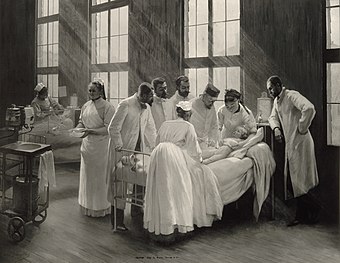 An injection against croup at the Hôpital Trousseau in Paris, with Roux observing, by P.A.A. Brouillet in 1893
An injection against croup at the Hôpital Trousseau in Paris, with Roux observing, by P.A.A. Brouillet in 1893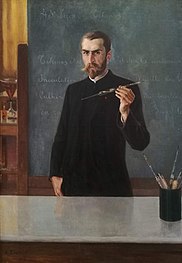 Dr. Emile Roux, Albert Edelfelt, 1896
Dr. Emile Roux, Albert Edelfelt, 1896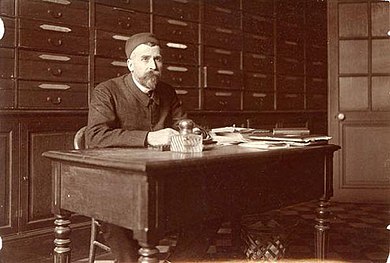 Office in 1906
Office in 1906_-_Veloso_Salgado_(Sala_dos_Actos%2C_FCM-UNL).png) 18th and 19th Century Medicine by Veloso Salgado in 1906, Pasteur at the center and Roux kneeling in front with the rabbit
18th and 19th Century Medicine by Veloso Salgado in 1906, Pasteur at the center and Roux kneeling in front with the rabbit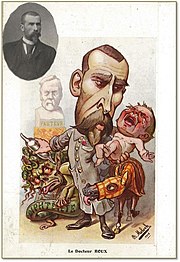 Friendly caricature of members of the Academy of Medicine designed by Hector Moloch and published in the journal Chanteclair in 1910
Friendly caricature of members of the Academy of Medicine designed by Hector Moloch and published in the journal Chanteclair in 1910.jpg) Roux, unknown date
Roux, unknown date 25th anniversary of the Pasteur Institute on 15 November 1913
25th anniversary of the Pasteur Institute on 15 November 1913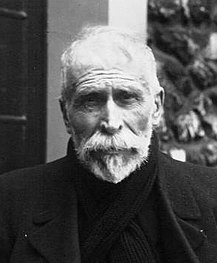 Roux in 1927
Roux in 1927
References
- "Pierre Paul Emile Roux. 1853-1933". Obituary Notices of Fellows of the Royal Society. 1 (3): 197. 1934. doi:10.1098/rsbm.1934.0005.
- a g, N. (1934). "Pierre Paul Emile Roux". Canadian Medical Association Journal. 30 (1): 70–71. PMC 403187. PMID 20319369.
- "Emile Roux, pilies de l'aventure Pasteur". Pasteur. Retrieved 11 July 2020.
- "293366 Roux (2007 EQ9)". Minor Planet Center. Retrieved 12 September 2019.
- "MPC/MPO/MPS Archive". Minor Planet Center. Retrieved 12 September 2019.
- Erhard F. Kaleta (2006): "A Brief History, Modes of Spread and Impact of Fowl Plague Viruses". Asia-Pacific Biotech News, volume 10, issue 14, pages 717-725. doi:10.1142/S0219030306001236
External links
| Wikimedia Commons has media related to Pierre Paul Émile Roux. |
- English biography of Pierre Paul Émile Roux. Pasteur Brewing
- Pierre Paul Émile Roux. Biographie. Institut Pasteur, Paris.
- Bibliography of P.P.E. Roux. Pasteur Institute.